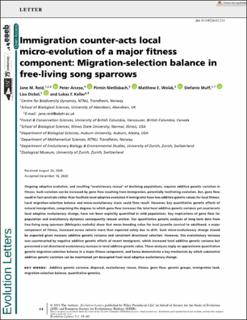| dc.contributor.author | Reid, Jane Margaret | |
| dc.contributor.author | Arcese, Peter | |
| dc.contributor.author | Nietlisbach, Pirmin | |
| dc.contributor.author | Wolak, Matthew | |
| dc.contributor.author | Muff, Stefanie | |
| dc.contributor.author | Dickel, Lisa | |
| dc.contributor.author | Keller, Lukas F. | |
| dc.date.accessioned | 2022-09-16T12:46:57Z | |
| dc.date.available | 2022-09-16T12:46:57Z | |
| dc.date.created | 2021-01-05T10:47:54Z | |
| dc.date.issued | 2021 | |
| dc.identifier.citation | Evolution Letters. 2021, 5 (1), 48-60. | en_US |
| dc.identifier.issn | 2056-3744 | |
| dc.identifier.uri | https://hdl.handle.net/11250/3018491 | |
| dc.description.abstract | Ongoing adaptive evolution, and resulting “evolutionary rescue” of declining populations, requires additive genetic variation in fitness. Such variation can be increased by gene flow resulting from immigration, potentially facilitating evolution. But, gene flow could in fact constrain rather than facilitate local adaptive evolution if immigrants have low additive genetic values for local fitness. Local migration-selection balance and micro-evolutionary stasis could then result. However, key quantitative genetic effects of natural immigration, comprising the degrees to which gene flow increases the total local additive genetic variance yet counteracts local adaptive evolutionary change, have not been explicitly quantified in wild populations. Key implications of gene flow for population and evolutionary dynamics consequently remain unclear. Our quantitative genetic analyses of long-term data from free-living song sparrows (Melospiza melodia) show that mean breeding value for local juvenile survival to adulthood, a major component of fitness, increased across cohorts more than expected solely due to drift. Such micro-evolutionary change should be expected given nonzero additive genetic variance and consistent directional selection. However, this evolutionary increase was counteracted by negative additive genetic effects of recent immigrants, which increased total additive genetic variance but prevented a net directional evolutionary increase in total additive genetic value. These analyses imply an approximate quantitative genetic migration-selection balance in a major fitness component, and hence demonstrate a key mechanism by which substantial additive genetic variation can be maintained yet decoupled from local adaptive evolutionary change. | en_US |
| dc.language.iso | eng | en_US |
| dc.publisher | Wiley Open Access | en_US |
| dc.rights | Navngivelse 4.0 Internasjonal | * |
| dc.rights.uri | http://creativecommons.org/licenses/by/4.0/deed.no | * |
| dc.title | Immigration counter-acts local micro-evolution of a major fitness component: migration-selection balance in free-living song sparrows | en_US |
| dc.title.alternative | Immigration counter-acts local micro-evolution of a major fitness component: migration-selection balance in free-living song sparrows | en_US |
| dc.type | Peer reviewed | en_US |
| dc.type | Journal article | en_US |
| dc.description.version | publishedVersion | en_US |
| dc.source.pagenumber | 48-60 | en_US |
| dc.source.volume | 5 | en_US |
| dc.source.journal | Evolution Letters | en_US |
| dc.source.issue | 1 | en_US |
| dc.identifier.doi | 10.1002/evl3.214 | |
| dc.identifier.cristin | 1865354 | |
| dc.relation.project | Norges forskningsråd: 223257 | en_US |
| cristin.ispublished | true | |
| cristin.fulltext | original | |
| cristin.qualitycode | 1 | |

